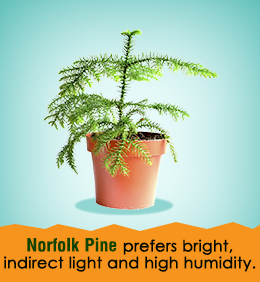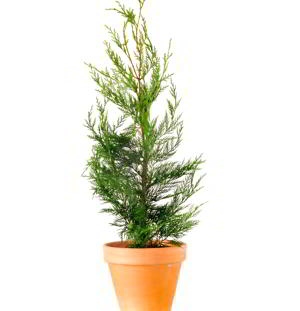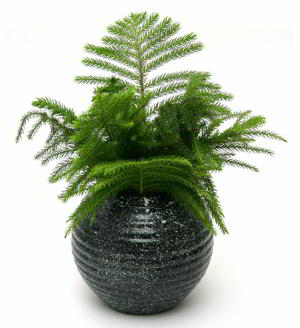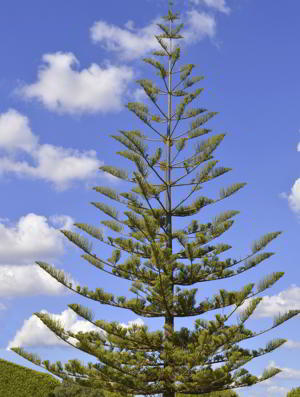





 Around 13 species that are similar in appearance to Norfolk pine are found in New Caledonia. Often mistaken for Norfolk Island pine, Cook pine or Araucaria columnaris is one of the species that is endemic to New Caledonia. While Norfolk pine trees are straight and upright, the trunk of Cook pine trees is slightly bent.The Norfolk Island pine tree is native to the Norfolk Island, which is located in the Pacific Ocean between Australia, New Zealand, and New Caledonia. It belongs to the cone-bearing Araucaria genus, Pinales order, and Araucariaceae family. Its scientific name is Araucaria heterophylla. In its natural habitat, this evergreen coniferous tree can attain a height of two hundred feet. It must be noted that Norfolk Island pine is not a true pine. Norfolk pine has been known to tolerate relatively low light levels. It can adapt well to the indoor environment.
Around 13 species that are similar in appearance to Norfolk pine are found in New Caledonia. Often mistaken for Norfolk Island pine, Cook pine or Araucaria columnaris is one of the species that is endemic to New Caledonia. While Norfolk pine trees are straight and upright, the trunk of Cook pine trees is slightly bent.The Norfolk Island pine tree is native to the Norfolk Island, which is located in the Pacific Ocean between Australia, New Zealand, and New Caledonia. It belongs to the cone-bearing Araucaria genus, Pinales order, and Araucariaceae family. Its scientific name is Araucaria heterophylla. In its natural habitat, this evergreen coniferous tree can attain a height of two hundred feet. It must be noted that Norfolk Island pine is not a true pine. Norfolk pine has been known to tolerate relatively low light levels. It can adapt well to the indoor environment.
 ✦ Genus: Araucaria
✦ Genus: Araucaria  Light RequirementsThe Norfolk pine plant is more likely to thrive if it is kept at a place that receives bright, indirect light. It doesn't need full sun, so keep it at a distance of 4-5 feet from a large window. Turn or rotate the plant every week, so that light is distributed well.You can keep it on an east, west, or north windowsill. It can be kept on a south window during the winter months or 12" away from a south-facing window in late spring and summer. It can also tolerate artificial incandescent or fluorescent lighting, but it needs at least 16 hours of light on a daily basis. However, a spot light is definitely a poor substitute for natural light. A plant that doesn't get natural light is not likely to survive for long.TemperatureIt is hardy to USDA zones 10-11. You can keep the plant outdoors in partial sunlight during summer. Put it outside after the danger of frost has passed, and bring it indoors before it frosts in the fall. Before bringing the plant indoors, keep it at a low-light transition place outdoors for a month. This is to ensure that the plant gets accustomed to the low-light conditions indoors.If the plant is suddenly placed indoors, the branches might start falling off. As far as the temperature is concerned, a daytime temperature between 65°F and 72°F will work well. The range for nighttime temperature is 50-55°F; nighttime temperature should not be lower than 45°F. Make sure that the plant is not exposed to warm or cold drafts or sudden changes in temperature.Soil Preference and WateringLike most plants, Norfolk pines also prefer a well-drained soil, with the soil pH between 4.5 and 5.5. Therefore, it is advisable to use a commercial potting mix that drains well. During summer, you will need to water this plant thoroughly once a week. This is to ensure that the soil remains slightly moist. Allow water to drain out from the drainage hole at the bottom of the container, and discard the excess water from the saucer. Don't let the plant stand on water. Check the soil for moisture. If the soil that's one inch below the surface feels dry, you need to water it. If the surface seems to be getting dry more than usual, then increase the frequency of watering. During winter, let the soil become dry before you water it again. However, the soil should never be waterlogged. Make sure that the pot or container has drainage holes. If the soil is too dry or waterlogged, the needles might start yellowing.HumidityThis plant needs high humidity or at least 50% relative humidity. During winter, the humidity levels can be significantly low. If the humidity levels are low, the tips of the needle-like foliage might start becoming brown. Besides tip browning, needle drop can also occur. Sometimes, the dry environment can cause the lower branches to fall off. Thus, it is advisable to increase the humidity. This can be achieved by using a dehumidifier. Keeping the plant on a pebble tray with water will also help. Mist the tree once a week.FertilizerApply a water-soluble balanced fertilizer (10-10-10) once a month during summer, or a balanced liquid fertilizer diluted by half can be applied twice a month from spring through fall. In case of mature plants, you can apply the fertilizer once every three months. If you have repotted your plant, you should apply the fertilizer after 4-5 months. The frequency of fertilizer application can be reduced, if the plant has attained the required height. Refrain from feeding the plant during winter. Do follow the manufacturer's guidelines regarding the application of the fertilizer.PruningRefrain from pruning this plant. All you need to do is snip off the brown tips and dead or damaged branches. The browning of the tips of needles could be a sign of problems with humidity or watering. Once the tips have become brown, there will be no growth. Thus, it is advisable to remove them. Pruning healthy foliage will stop new growth. So, don't touch the healthy foliage.RepottingAs far as repotting this plant is concerned, you can use a commercially available potting mix. These plants can be repotted in the spring every three to four years. If the plant has attained the required height, let it remain in the same pot, allowing it to become root bound. Instead of repotting, you can remove the top 2-3 inches of soil and replace with fresh soil once in a couple of years. However, try not to cause damage to the roots that might be present at the surface.While Norfolk Island pine can be propagated from seeds, it will take a long time for the plant to grow. Therefore, it would best to purchase a plant instead. Make sure that you buy a plant that has dark green needles. There should be enough space in the pot for the branches to grow. Though these plants are often sold as Christmas trees, it is advisable to not hang heavy ornaments on the branches. This plant requires humidity, so refrain from hanging electric lights. To keep the needles healthy, provide the plant with bright light and the required humidity.
Light RequirementsThe Norfolk pine plant is more likely to thrive if it is kept at a place that receives bright, indirect light. It doesn't need full sun, so keep it at a distance of 4-5 feet from a large window. Turn or rotate the plant every week, so that light is distributed well.You can keep it on an east, west, or north windowsill. It can be kept on a south window during the winter months or 12" away from a south-facing window in late spring and summer. It can also tolerate artificial incandescent or fluorescent lighting, but it needs at least 16 hours of light on a daily basis. However, a spot light is definitely a poor substitute for natural light. A plant that doesn't get natural light is not likely to survive for long.TemperatureIt is hardy to USDA zones 10-11. You can keep the plant outdoors in partial sunlight during summer. Put it outside after the danger of frost has passed, and bring it indoors before it frosts in the fall. Before bringing the plant indoors, keep it at a low-light transition place outdoors for a month. This is to ensure that the plant gets accustomed to the low-light conditions indoors.If the plant is suddenly placed indoors, the branches might start falling off. As far as the temperature is concerned, a daytime temperature between 65°F and 72°F will work well. The range for nighttime temperature is 50-55°F; nighttime temperature should not be lower than 45°F. Make sure that the plant is not exposed to warm or cold drafts or sudden changes in temperature.Soil Preference and WateringLike most plants, Norfolk pines also prefer a well-drained soil, with the soil pH between 4.5 and 5.5. Therefore, it is advisable to use a commercial potting mix that drains well. During summer, you will need to water this plant thoroughly once a week. This is to ensure that the soil remains slightly moist. Allow water to drain out from the drainage hole at the bottom of the container, and discard the excess water from the saucer. Don't let the plant stand on water. Check the soil for moisture. If the soil that's one inch below the surface feels dry, you need to water it. If the surface seems to be getting dry more than usual, then increase the frequency of watering. During winter, let the soil become dry before you water it again. However, the soil should never be waterlogged. Make sure that the pot or container has drainage holes. If the soil is too dry or waterlogged, the needles might start yellowing.HumidityThis plant needs high humidity or at least 50% relative humidity. During winter, the humidity levels can be significantly low. If the humidity levels are low, the tips of the needle-like foliage might start becoming brown. Besides tip browning, needle drop can also occur. Sometimes, the dry environment can cause the lower branches to fall off. Thus, it is advisable to increase the humidity. This can be achieved by using a dehumidifier. Keeping the plant on a pebble tray with water will also help. Mist the tree once a week.FertilizerApply a water-soluble balanced fertilizer (10-10-10) once a month during summer, or a balanced liquid fertilizer diluted by half can be applied twice a month from spring through fall. In case of mature plants, you can apply the fertilizer once every three months. If you have repotted your plant, you should apply the fertilizer after 4-5 months. The frequency of fertilizer application can be reduced, if the plant has attained the required height. Refrain from feeding the plant during winter. Do follow the manufacturer's guidelines regarding the application of the fertilizer.PruningRefrain from pruning this plant. All you need to do is snip off the brown tips and dead or damaged branches. The browning of the tips of needles could be a sign of problems with humidity or watering. Once the tips have become brown, there will be no growth. Thus, it is advisable to remove them. Pruning healthy foliage will stop new growth. So, don't touch the healthy foliage.RepottingAs far as repotting this plant is concerned, you can use a commercially available potting mix. These plants can be repotted in the spring every three to four years. If the plant has attained the required height, let it remain in the same pot, allowing it to become root bound. Instead of repotting, you can remove the top 2-3 inches of soil and replace with fresh soil once in a couple of years. However, try not to cause damage to the roots that might be present at the surface.While Norfolk Island pine can be propagated from seeds, it will take a long time for the plant to grow. Therefore, it would best to purchase a plant instead. Make sure that you buy a plant that has dark green needles. There should be enough space in the pot for the branches to grow. Though these plants are often sold as Christmas trees, it is advisable to not hang heavy ornaments on the branches. This plant requires humidity, so refrain from hanging electric lights. To keep the needles healthy, provide the plant with bright light and the required humidity.
Copyright © www.100flowers.win Botanic Garden All Rights Reserved